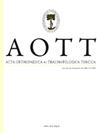腰椎退变及其与关节突关节囊和黄韧带胶原、弹性蛋白表达的关系
IF 1.1
4区 医学
Q3 ORTHOPEDICS
引用次数: 1
摘要
目的:本研究旨在评估弹性蛋白、I、II、III型胶原的表达与小关节囊和黄韧带变性之间的关系。方法:本研究包括10例(4男6女)(平均年龄61±14,9)退行性腰椎综合征手术患者和5具(3男2女)(死亡年龄87±8.6岁)尸体。术中从患者组的每个患者身上采集一组组织样本,从尸体组的每个尸体身上采集两组样本,分别取自L4/5节段的黄韧带(内侧和外侧)和小关节囊(上关节突和下关节突)。对I、II、III型胶原和弹性蛋白进行蛋白质印迹分析。根据Pfirmann分类法对椎间盘退变进行评分,根据藤原分类法对小关节关节病进行评分,并研究它们与蛋白质表达的关系。结果:与身体供体组(BDG)相比,患者组(PG)的小关节囊(FJC)和黄韧带外侧样本中I型胶原表达强烈。FJC的样本显示PG中弹性蛋白的表达低于BDG,但没有统计学意义。与PG中的弹性蛋白相比,I型胶原的表达增加。相反,与I型胶原相比,BDG组的样品中弹性蛋白占主导地位(I型胶原/弹性蛋白PG:PAsup 2,78;PAinf 2,61;LFmed 2,23;225 LFlat 1,83;BDG:PAsup 0,15;PAinf0,2;LFmed0,2,LFlat 0,27)。Spearman的秩相关系数显示,I型、III型胶原和弹性蛋白与Pfirrmann的椎间盘退变程度和Fujiwara的小关节骨关节炎程度之间存在低到中等相关性,所有这些都没有统计学意义。结论:本研究表明,在腰椎退行性变化的情况下,I型胶原的表达增加,并且比弹性蛋白占优势。证据级别:三级,诊断研究本文章由计算机程序翻译,如有差异,请以英文原文为准。
Degeneration of the lumbar spine and its relation to the expression of collagen and elastin in facet joint capsules and ligament flavum
Objective: The aim of the study was to assess the relationship between the expression of elastin, collagen type I, II,III and the degeneration of the facet joint capsule and the ligamentum flavum. Methods: 10 patients (4 male, 6 female) (mean age 61 ± 14,9) undergoing surgery for degenerative lumbar spine syndrome and 5 cadavers (3 male, 2 female) (age of death 87 ± 8,6 years) were included in this study. One set of tissue samples was taken from each patient in the patient group intraoperatively and two sets of samples were taken from each cadaver in the cadaver group posthumosly from the ligamentum flavum (medial and lateral) and from the facet joint capsules (superior and inferior articular process) at the L4/5 segment.Western blot analysis was performed for collagen types I, II, III and for elastin. Disc degeneration was scored according to the Pfirmann Classification, facet joint arthrosis was scored according to the Fujiwara Classification and their relationship with protein expression was investigated. Results: There was a strong expression of Collagen type I in the patient group (PG) compared to the body donor group (BDG) in the facet joint capsule (FJC) and in the lateral samples of the ligamentum flavum. Samples of the FJC showed lower expression of elastin in the PG compared with the BDG, but without statistical significance. An increased expression of collagen type I compared to elastin in the PG could be shown. In contrast, elastin predominated in the samples of the BDG group compared to collagen type I (collagen type I/ elastin PG: PAsup 2,78; PAinf 2,61; LFmed 2,23; 225 LFlat 1,83; BDG: PAsup 0,15; PAinf 0,2; LFmed 0,2; LFlat 0,27). Rank correlation coefficient according to Spearman showed low to moderate correlations for collagen type I, III and elastin for the degree of disc degeneration according to Pfirrmann and the degree of facet joint osteoarthritis according to Fujiwara, all of them without statistical significance. Conclusion: This study has shown us that in the context of degenerative changes of the lumbar spine, there is an increased expression of collagen type I and a dominance over elastin. Level of Evidence: Level III, Diagnostic Study
求助全文
通过发布文献求助,成功后即可免费获取论文全文。
去求助
来源期刊

Acta orthopaedica et traumatologica turcica
ORTHOPEDICS-
CiteScore
2.00
自引率
0.00%
发文量
66
审稿时长
>12 weeks
期刊介绍:
Acta Orthopaedica et Traumatologica Turcica (AOTT) is an international, scientific, open access periodical published in accordance with independent, unbiased, and double-blinded peer-review principles. The journal is the official publication of the Turkish Association of Orthopaedics and Traumatology, and Turkish Society of Orthopaedics and Traumatology. It is published bimonthly in January, March, May, July, September, and November. The publication language of the journal is English.
The aim of the journal is to publish original studies of the highest scientific and clinical value in orthopedics, traumatology, and related disciplines. The scope of the journal includes but not limited to diagnostic, treatment, and prevention methods related to orthopedics and traumatology. Acta Orthopaedica et Traumatologica Turcica publishes clinical and basic research articles, case reports, personal clinical and technical notes, systematic reviews and meta-analyses and letters to the Editor. Proceedings of scientific meetings are also considered for publication.
The target audience of the journal includes healthcare professionals, physicians, and researchers who are interested or working in orthopedics and traumatology field, and related disciplines.
 求助内容:
求助内容: 应助结果提醒方式:
应助结果提醒方式:


